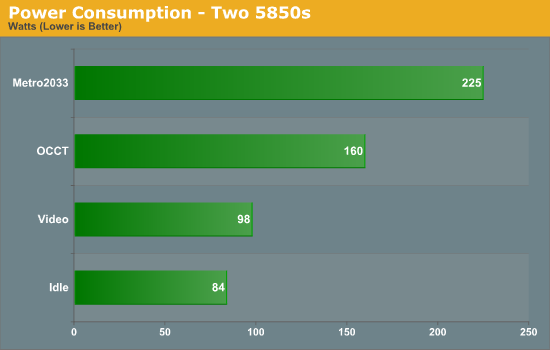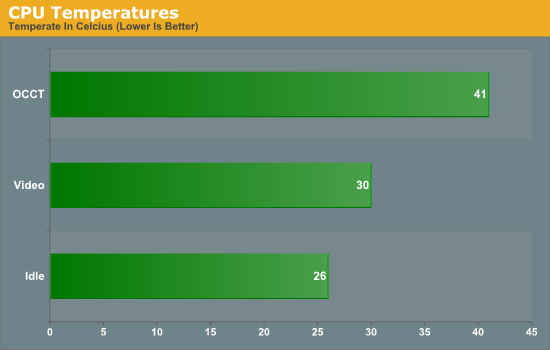ASUS F1A75-M Pro Review - Micro-ATX Llano at $110
by Brendan van Varik on January 22, 2012 2:00 AM EST- Posted in
- Motherboards
- Asus
- Llano
Test Setup
| Processor |
AMD Llano A6-3650 4 Cores, 4 Threads, 2.6 GHz |
| Motherboards | ASUS F1A75-M Pro |
| Cooling | Thermalright Ultra 120 Extreme |
| Memory | G.Skill RipjawsX Series 16GB (4x4GB) DDR3-1866MHz |
| Memory Settings | DDR3-1866MHz - 9-10-9-24 1T at 1.65v |
| Video Cards | Sapphire Radeon HD 5850 1GB |
| Video Drivers | 11.8 |
| Hard Drive | Micron C300 |
| Optical Drive | Samsung SH-S223Q |
| Case | Dimastech Bench Table |
| Operating System | Windows 7 64-bit Ultimate |
| SATA Testing | Micron C300 |
| USB 2/3 Testing | Patriot 64GB SuperSonic USB 3.0 |
Power Consumption
Power consumption was tested on the system as a whole with a wall meter connected to the power supply, while in a dual GPU configuration. This method allows us to compare the power management of the UEFI and the board to supply components with power under load, and includes typical PSU losses due to efficiency. These are the real world values that consumers may expect from a typical system (minus the monitor) using this motherboard.

Power usage across the board is highly representative of a typical Llano system.
CPU Temperatures
With most users’ running boards on purely default BIOS settings, we are running at default settings for the CPU temperature tests. This is, in our outward view, an indication of how well (or how adventurous) the vendor has their BIOS configured on automatic settings. With a certain number of vendors not making CPU voltage, turbo voltage or LLC options configurable to the end user, which would directly affect power consumption and CPU temperatures at various usage levels, we find the test appropriate for the majority of cases. This does conflict somewhat with some vendors' methodology of providing a list of 'suggested' settings for reviewers to use. But unless those settings being implemented automatically for the end user, all these settings do for us it attempt to skew the results, and thus provide an unbalanced 'out of the box' result list to the readers who will rely on those default settings to make a judgment. CPU Temperatures are not really indicative of quality or performance, even though one would postulate that worse parts may produce higher temperatures. However, if a manufacturer uses more conductive material in the power plane, this reduces resistance and increases the voltage at the CPU, causing a higher temperature but potentially better stability.











32 Comments
View All Comments
ASUSTechMKT - Monday, January 23, 2012 - link
Have not tested 3870K but tried the 3670K and was easily able to hit to 3.8GHz no APU bus adjustment just multipler. I tested this on -M, -V Pro, -V EVO and -I Deluxe. Make sure though you updated to the latest UEFI to correctly and fully support the K series APUs.ET - Sunday, January 22, 2012 - link
That "Level Up!!" text on the TurboV EVO screen made me think that it would be cool if playing with the BIOS could be made into a game. Give achievements for exploring the BIOS, up the user's hardware hacker level when he changes stuff successfully without making the PC unbootable.Basilisk - Sunday, January 22, 2012 - link
(Here's my chance to look dim.)Looking at the comparison table on the first page, I thought "Oh crud... they dropped eSata on the uATX board." eSata's my fetish, I suppose. Then I read the "Board Features" on "Inside the Box" and did a double-take when it listed "1 x eSATA 6 Gbps", so my hopes rose... until I looked a the pix of the back-panel and the box contents [for brackets].
Alas, I suspect you've a (minor) error and the eSata's missing. Even sadder that it's missing on the ITX board, as external resources and backups become even more valuable (to me) there.
Death666Angel - Sunday, January 22, 2012 - link
The ITX board has eSata on the I/O shield, just look at the review pics at the bottom of this page:http://www.anandtech.com/show/4833/asus-f1a75i-del... (It's between the clear CMOS and DVI and below the 2 red USB ports.)
This mATX board doesn't have eSata on the I/O shield and doesn't provide a PCI bracket, but you can always purchase one of those for $2. :-)
Soulkeeper - Sunday, January 22, 2012 - link
The mini-itx is expensive in part because of the wireless keyboard and wifi.It's worthless for overclocking mostly due to the lack of a higher bclk divider.
To be honest if I wanted a matx fm1 motherboard I'd go with gigabyte's solution.
ASUSTechMKT - Monday, January 23, 2012 - link
our - I Deluxe has been tested to reach the same performance numbers ( APU bus scaling and multipler scaling for K series as the rest of our F1A boards ( -V Pro or -M Pro ). latest UEFI is recommended if you want to have highest potential under both AHCI and IDE ranges.bobbyto34 - Monday, January 23, 2012 - link
thanks a lot for the dpc latency test ! It's very useful for musicians when you want to buy a rig for audio recording !DaneelSE - Monday, January 23, 2012 - link
One promising use for a u-ATX board is using it as a base for a HTPC build. Somehow there seem to be a lack of interest in this arena from reviewers.It would be very interesting to see a real life use scenario benchmarked with power usage. How low can we push a platform in power usage wjhile still performing a few mundane tasks simultaneously.
Just brainstorming here to give an example of possible tasks that would be run at the same time.
1. Watching a DVB-T HD-channel
2. Recording a second channel on a different MUX
3. Transcoding a third recording on low priority
4. Have a internet browser in the background with some predefined work load.
It would be very interesting to see this as a usage case where the reviewer tries to push the power usage down while conserving the end user experience.
I think it would be interesting to see how AMD probably beats Intel until Ivybridge get released and then possibly see a throne shift back and forth a few times.
cjs150 - Monday, January 23, 2012 - link
Sadly just about the only sensible use for Llano is in an HTPC build. (or as low powered laptop which it is very good at).Problem for me is that our cable operator (Virgin) has a TiVo box which lets me watch one channel and record 2 at same time so any HTPC build I do only really needs a mini-itx board (and complete silence!). Hoping that the reviews of Zotac's announcements at CES will take away need for building my own.
Anyway back to a proper HTPC build. The main issues are:
1. Noise. Fans not allowed (except at very low RPM). I want to hear the TV not the HTPC - this is a big problem for me with my Blu-ray player.
2. Sound. There is a big debate as to whether sound is better going through HDMI port or not. Personally I prefer fewer cables to more and my ears are not good enough to tell the difference so sound has tobe routed through HDMI
3. Picture quality: Obviously vital for an HTPC and a big plus for AMD, happy to use integrated graphics here provided (Intel note) frame rate is perfect. Using Integrated graphics frees up a PCI/PCI-E slot for something else.
4. TV card or cards: Dual channel is minimum acceptable.
So for me I can probably built a nice HTPC using mini-itx but if you want to use the full potential of a Micro-Atx you could build one say with 2xdual channel TV cards, separate sound card and GPU - cooling and noise would be an issue though
DaneelSE - Monday, January 23, 2012 - link
I fully understand the limitations and possibilities, and probably am able to work this out by myself.My comment was aimed at how a u-atx review is done. There are a few different target readers.
1. Gamers that want their box as small as possible (Did I hear Zotac Z68-ITX WiFi)
2. HTPC builders that want a all in one solution
3. Small desktop builds where the extra PCIe slots are vital
4. Small server/storage builds
I understand that every review can't cover all bases, but surely a HTPC oriented series of reviews would get a lot of clicks and readers.
Regarding your itemized list
1. good comment and I somehow think consumed power relates to cooling needed. Fan and noise belongs in Case-reviews.
2. Separate review, however the onboard quality should be measured, if nothing else using RMAA
3. I know that Anandtech has reviewers specialized in this area and it should of course be included if IGP is present, if nothing else to indicate when discrete is needed to reach acceptable levels.
4. Agree, wouldn't make sense otherwise, and still debatable if you really need to go as high as u-ATX.